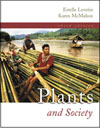
Origins of Agriculture |  |
Chapter Summary1. The first human societies were based on a foraging lifestyle, gathering wild plants and hunting animals for food. Archeological investigations have determined that the diet of Stone Age foragers was varied, especially in the variety of plants consumed. Studies on the diet and lifestyle of extant foragers, especially the !Kung San of the Kalahari Desert, reinforce the viewpoint that the foraging lifestyle more than satisfies the nutritional requirements yet allows time for activities not directed to food gathering and preparation.
2. The archeological record indicates that, at least in some parts of the world, certain groups began to shift from the nomadic, foraging lifestyle to the sedentary one of agriculture. Many theories to explain this shift have been presented and discarded over the years, but the currently held view believes that the switch to agriculture was gradual. A prolonged transitional stage ensued in which groups formed settlements but sent out members to hunt and gather.
3. The earliest agricultural settlements, approximately 11,500 years old, have been found in the Far East along the Yangtze River valley. Sites in the Near East, in an area known as the Fertile Crescent, also document early agriculture. The New World dates from the Tehuacan and Oaxaca valleys of Mexico show that agriculture started at approximately the same time.
4. Domesticated plants and animals are genetically different from their wild relatives because they have been shaped by artificial selection. Many of the traits, such as a nonshattering fruiting heads, do not enhance a plant’s survival value but have been selected to suit humanity’s needs.
5. Because domesticated plants have been modified greatly from their wild ancestors after thousands of years of artificial selection, it has often been difficult to pinpoint their area of origin. Nikolai I. Vavilov laid the foundation for detecting the centers of origin of domesticated plants when he proposed eight centers, six in the Old World and two in the New.
|
|
|